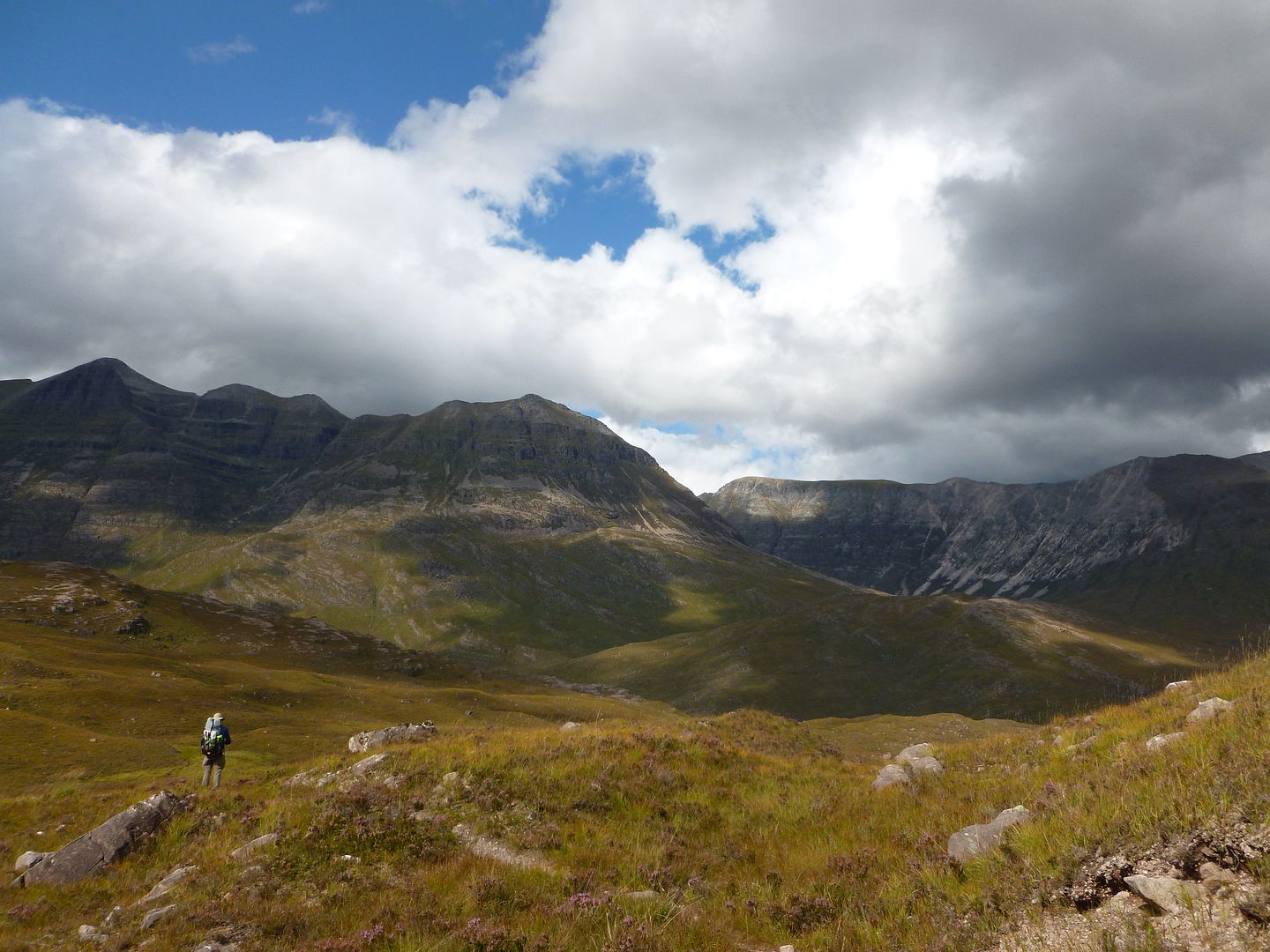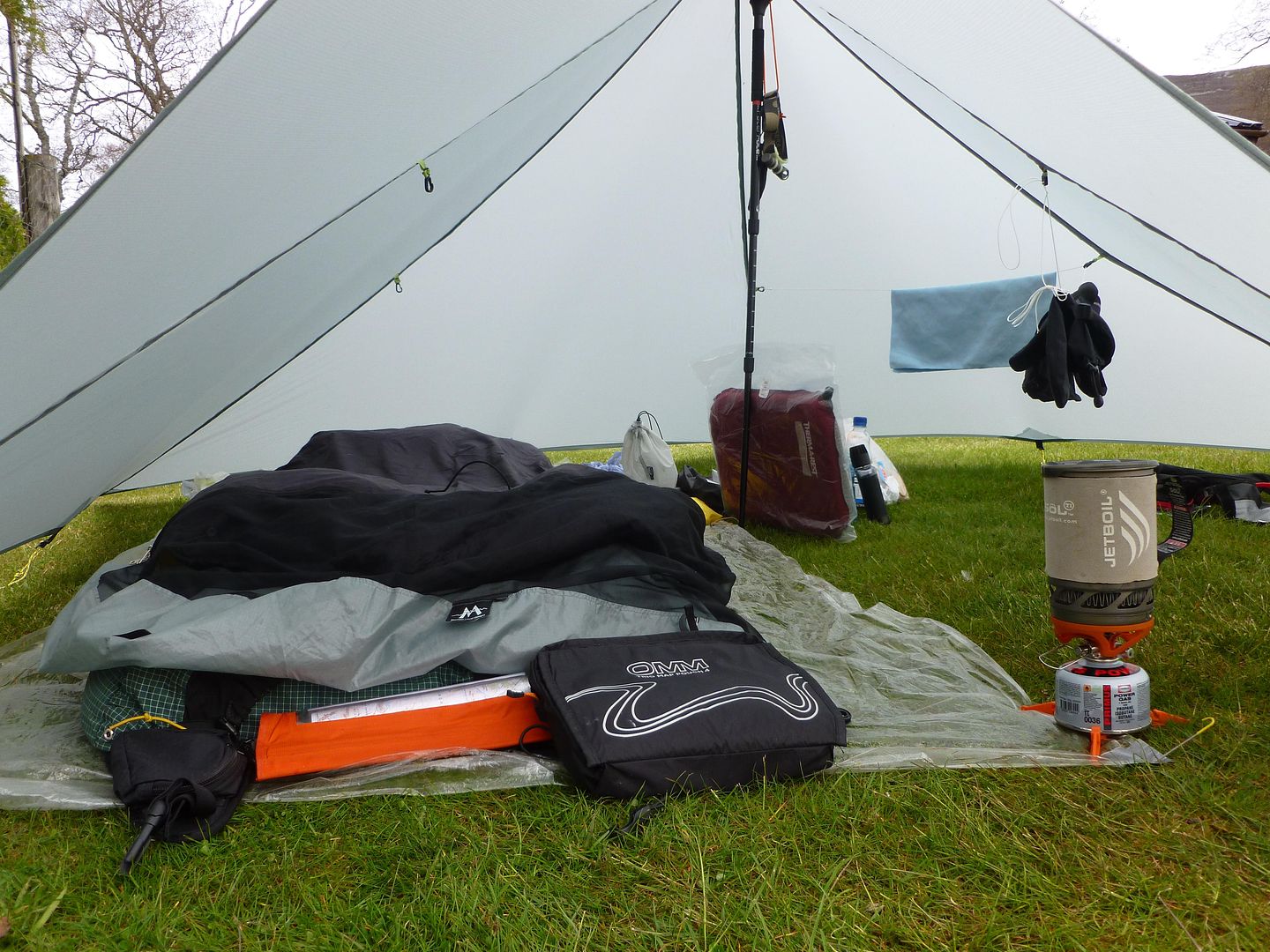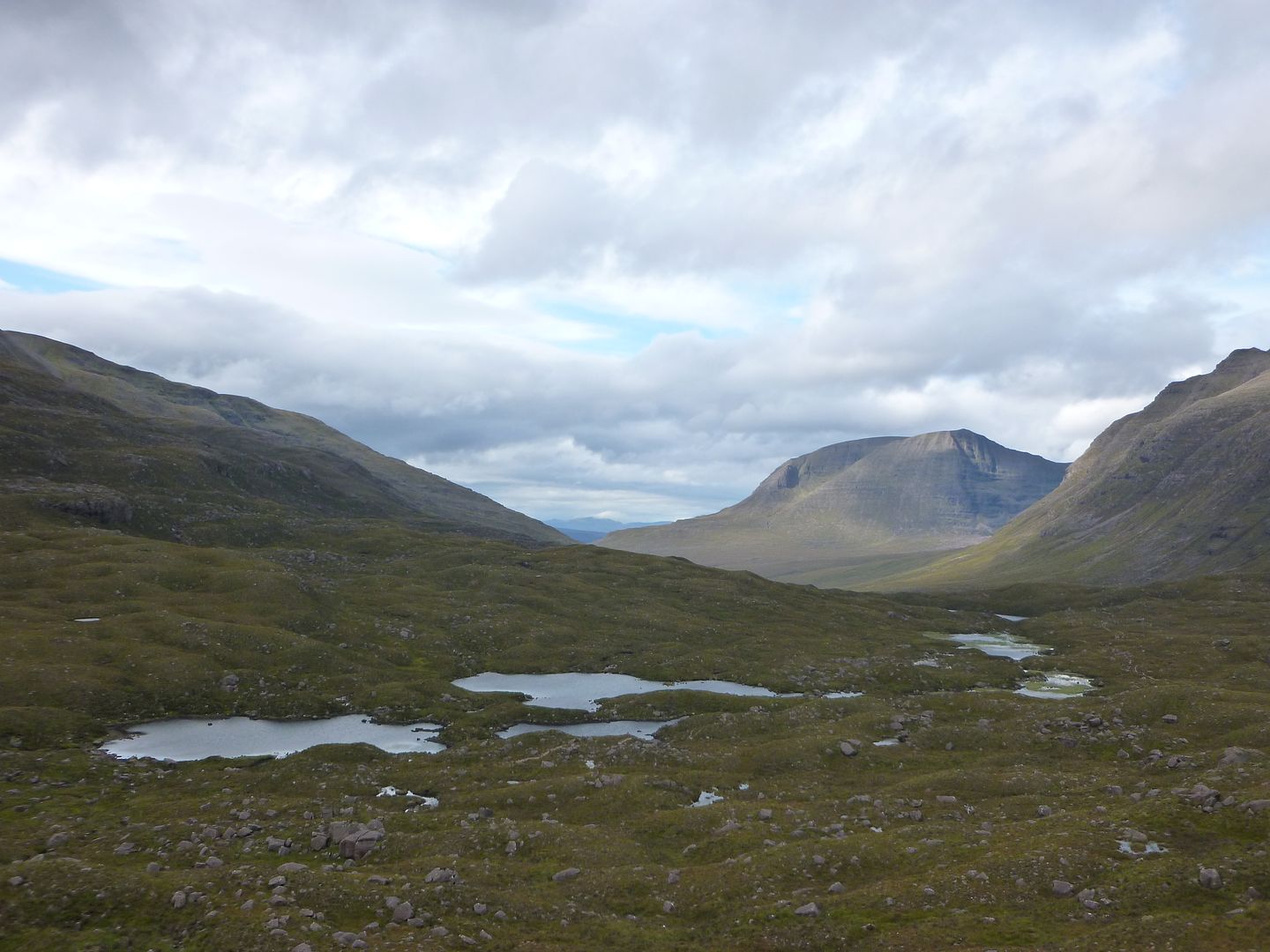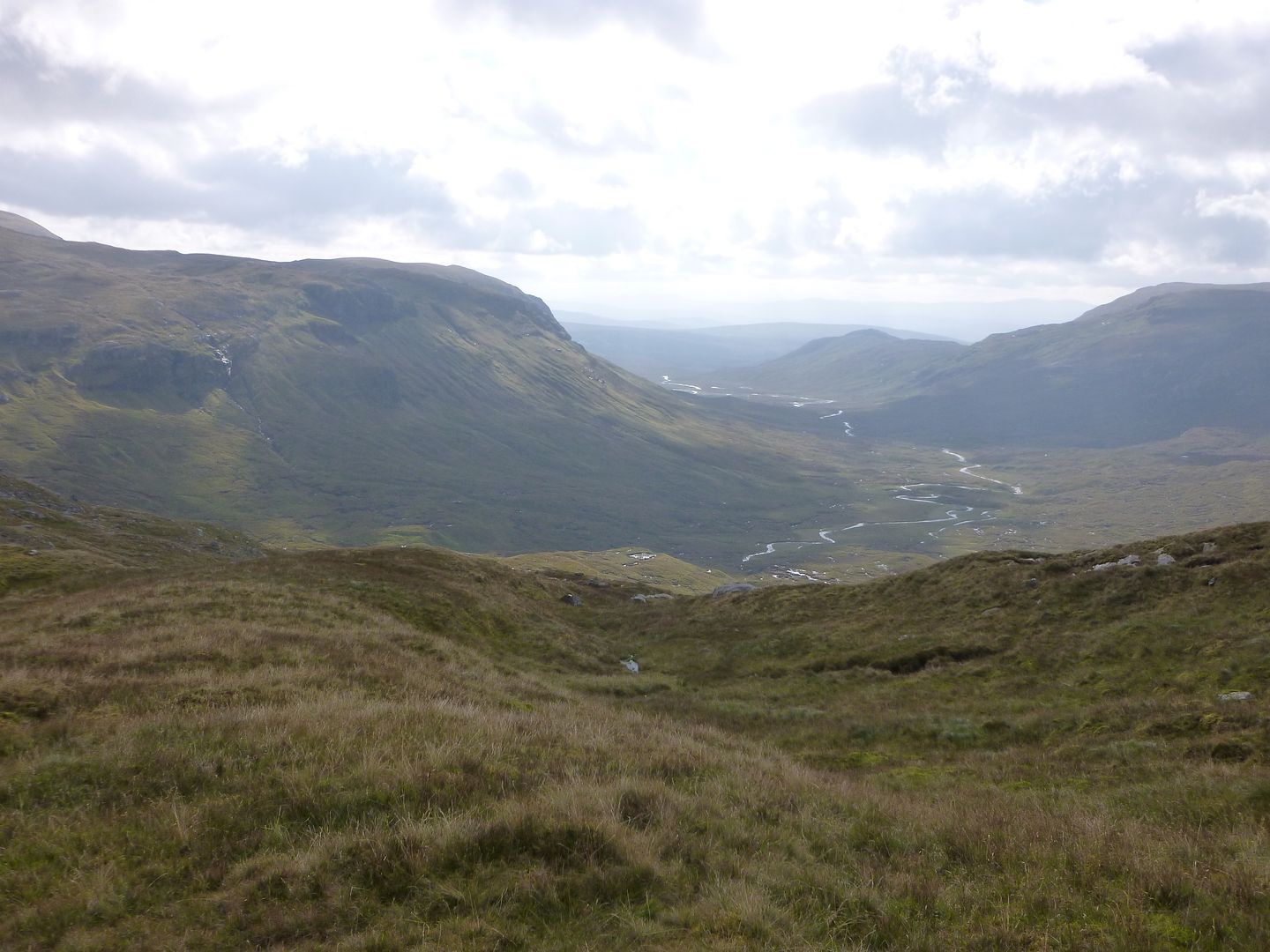I thought it might be interesting to see how folk look at footwear choices and how you take care of your feet on long multiday hikes. I have a system, I'm not sure it's the best so looking to pick up some ideas with this one.
Generally speaking I think there's two different approaches to footwear choice, you either use a membraned shoe or boot and try to keep your feet dry, or you opt for a lighter, more minimal shoe and use a different process for looking after your feet, pro's and cons of each have been debated previously. I fall into the latter, it's quite a new idea to me having always been a firm believer that footwear for the hills should be heavy, robust and waterproof, it's only in the last three or four years that I've switched to a light trail shoe. The weather being what it is over here, there's a good chance on a long trip that with a light shoe your feet are going to get wet, sometimes for sustained periods, unless you take steps to look after your plates, day after day with wet feet starts to get unpleasant.
I still use a boot in winter for a number of reasons, if there's snow down I'm likely to be wearing a gaiter of some kind and there's a good chance I'll be wanting to keep my feet warm and dry, for the sake of this discussion let's stick to trail shoe routines.
Weather permitting I tend to go with ..
Scarpa ZG10 boots for the colder months:- November - February
Inov8 or Salomons for the warmer months:- March - October
When I was training for the TGOC in 2012 I bought a pair of Croc copies from the local market, they were part of my kit until I came to do the final pack for the trip. Because of the bulk I decided to drop them and regretted it for the whole trip, my hiking partner did take his I was supremely jealous at the end of each day when he had alternative footwear to slip on. Since the TGO, for longer trips (a week+) I've taken a second pair of footwear for evenings, more recently a pair of Vivo Barefoot Ultras which are lighter and more packable than Crocs. Fort shorter trips I'll take a pair of ankle length light Sealskinz, these can be worn inside wet footwear but still allow you treat and dry them first.
Dry Days
On the Trail
When the weather is dry and ground conditions are good, I wear two pairs of thin socks. A pair of Bridgedale Coolmax liners and a pair of X-Socks Trekking Expedition over the top. I find the Tactel liners do a great job of keeping my feet cool, they also wick moisture away from my feet and out to the X-Socks.

Camp Routine
After a dry day moisture from sweat has built up in the shoes and socks, it's not always noticeable if it's pleasant weather but it will be there. I'll often keep my day socks on until I'm ready to retire for the night, at which point I'll give my feet a wash with Dr Bronners soap, then powder them Boots antibacterial foot powder and slip on a pair of bed socks. Depending on the weather these can be anything from a pair of light merino socks or if it's cold enough a pair of phd down booties. Overnight I'll remove my insoles and stand them up in my shoes, I find this gives them a good airing ready for the next day.
Extra
If mileage has been high or the terrain has been rough, there's a good chance with light shoes that feet might be a little tender at the end of the day, on days like these I find it helps to give them a bit more TLC. For this I use Gehwol foot creams, an antibacterial soothing and refreshing balm in the evenings and a barrier cream to reduce friction and chafing, this is applied in the morning ahead of a days walking. I use small 10ml aluminium screw top tins for my Gehwols, a green or red Airfix enamel spot on the lid shows which is which in my wash kit.
Wet Days
On the Trail
For soggy days, of which there are many, I still use the same shoe and sock system, I find two pairs of thin socks provide better blister protection when the feet are wet and vulnerable. With a light trail shoe and inclement weather it's inevitable that your feet are going to get wet at some point, for me that's usually five minutes down the trail in heavy rain. Wet feet can be warm feet though and eventually you don't even notice they're wet, if the weather breaks I find my shoes can be more or less dry after around 20 minutes.
Camp Routine
Arriving in camp with wet feet usually means I attend to them as soon as the shelter is up and I can get sorted. If I have my Vivos with me I'll get them on straight away and let my feet get some air, if I've packed Sealskinz I'll wash, dry and powder my feet before slipping them on.
Wet days can include bog crossings and river crossings, both of which mean you pick up debris as well as just water. A lot of the Scottish rivers I cross contain fine silt particles which can accumulate in the footbed and can cause blisters later. After days like these I make the effort to give my shoes and socks a good rinse out, taking out the insoles you can see the silt beginning to build up under the forefoot.
Overnight my insoles are propped up in my shoes again, if my shoes are sodden I'll move them to the side of my shelter which is catching the wind in the hope they'll dry a bit better, both pairs of socks are hung from a 1mm line hung inside my shelter. Depending on damp, airflow and condensation, by morning my shoes and socks can be anything from still sodden to almost dry.

Extra
My feet do start to fall apart after multiple days in the wet, I have to keep on top of them otherwise I'm in bits after a week or so. Getting them dried and getting air to them I find works best for me, I know some folk have issues with powders blocking pores but it's not been an issue for me as far as I know. I'll sometimes give the Gehwols refreshing balm as miss after a wet day, preferring to keep my feet as clean and natural as I can. If it's wet again the next day I will start by applying Gehwols extra and then put on the damp socks from the previous day, and then the damp shoes. It can feel chilly at first but after five minutes of packing away camp my feet have usually warmed up enough that they no longer feel wet.
Other
River Crossings
Walk any kind of distance in the UK and you'll eventually be faced with a river crossing, folk have come up with some weird and wonderful solutions to footwear concerns but my approach is very simple. I just roll up my trouser legs and walk on through, shoes socks and all. If it's a dry day, twenty minutes down the trail and you're feet will be more or less dry, if it's a soggy day much of the water will drain fairly quickly but then I still follow the Wet Days system.
Bog Crossings
Much the same process as river crossings but I don't bother rolling up my trousers. On long stretches of bog you eventually give up trying to find the dry patches and just have to plough on through anyway, do enough of these and you begin to approach bogs differently. After some long bog days my feet have been an interesting colour, unless there's hot soapy water available it's just something you live with until you find a campsite and shower

Heather Bashing
One item I add to my kit if I know there's heather to be bashed is a pair of light ankle gaiters, currently Rab Scree gaiters. With a low cut trail shoe I find them a magnet for sucking in bits of heather and irritating my feet, something light and quick drying is useful, waterproof is a waste of time with a pair of unlined trail shoes, the only thing you'll achieve is trapping moisture around your ankle.
Blisters
I've never really suffered too badly with blisters so I've not had a lot of experience with dealing with them. When I have I'm one of those who prefers to pop and drain them as soon as possible, I'll use a sterile needle to pop it, then toilet paper to wipe clean before applying a small dab of Savalon. Again I find lots of airflow helps with the healing process, once the skin has dried out I'll either leave it until I'm home or remove it with a sterile scalpel blade.

That's kind of how I look after my feet and how I might prep for an upcoming trip, I hope it might be useful for somebody looking to try a trail shoe instead of a boot, I'll be interested to hear how others approach the same subject.
Generally speaking I think there's two different approaches to footwear choice, you either use a membraned shoe or boot and try to keep your feet dry, or you opt for a lighter, more minimal shoe and use a different process for looking after your feet, pro's and cons of each have been debated previously. I fall into the latter, it's quite a new idea to me having always been a firm believer that footwear for the hills should be heavy, robust and waterproof, it's only in the last three or four years that I've switched to a light trail shoe. The weather being what it is over here, there's a good chance on a long trip that with a light shoe your feet are going to get wet, sometimes for sustained periods, unless you take steps to look after your plates, day after day with wet feet starts to get unpleasant.
I still use a boot in winter for a number of reasons, if there's snow down I'm likely to be wearing a gaiter of some kind and there's a good chance I'll be wanting to keep my feet warm and dry, for the sake of this discussion let's stick to trail shoe routines.
Weather permitting I tend to go with ..
Scarpa ZG10 boots for the colder months:- November - February
Inov8 or Salomons for the warmer months:- March - October
When I was training for the TGOC in 2012 I bought a pair of Croc copies from the local market, they were part of my kit until I came to do the final pack for the trip. Because of the bulk I decided to drop them and regretted it for the whole trip, my hiking partner did take his I was supremely jealous at the end of each day when he had alternative footwear to slip on. Since the TGO, for longer trips (a week+) I've taken a second pair of footwear for evenings, more recently a pair of Vivo Barefoot Ultras which are lighter and more packable than Crocs. Fort shorter trips I'll take a pair of ankle length light Sealskinz, these can be worn inside wet footwear but still allow you treat and dry them first.
Dry Days
On the Trail
When the weather is dry and ground conditions are good, I wear two pairs of thin socks. A pair of Bridgedale Coolmax liners and a pair of X-Socks Trekking Expedition over the top. I find the Tactel liners do a great job of keeping my feet cool, they also wick moisture away from my feet and out to the X-Socks.

Camp Routine
After a dry day moisture from sweat has built up in the shoes and socks, it's not always noticeable if it's pleasant weather but it will be there. I'll often keep my day socks on until I'm ready to retire for the night, at which point I'll give my feet a wash with Dr Bronners soap, then powder them Boots antibacterial foot powder and slip on a pair of bed socks. Depending on the weather these can be anything from a pair of light merino socks or if it's cold enough a pair of phd down booties. Overnight I'll remove my insoles and stand them up in my shoes, I find this gives them a good airing ready for the next day.
Extra
If mileage has been high or the terrain has been rough, there's a good chance with light shoes that feet might be a little tender at the end of the day, on days like these I find it helps to give them a bit more TLC. For this I use Gehwol foot creams, an antibacterial soothing and refreshing balm in the evenings and a barrier cream to reduce friction and chafing, this is applied in the morning ahead of a days walking. I use small 10ml aluminium screw top tins for my Gehwols, a green or red Airfix enamel spot on the lid shows which is which in my wash kit.
Wet Days
On the Trail
For soggy days, of which there are many, I still use the same shoe and sock system, I find two pairs of thin socks provide better blister protection when the feet are wet and vulnerable. With a light trail shoe and inclement weather it's inevitable that your feet are going to get wet at some point, for me that's usually five minutes down the trail in heavy rain. Wet feet can be warm feet though and eventually you don't even notice they're wet, if the weather breaks I find my shoes can be more or less dry after around 20 minutes.
Camp Routine
Arriving in camp with wet feet usually means I attend to them as soon as the shelter is up and I can get sorted. If I have my Vivos with me I'll get them on straight away and let my feet get some air, if I've packed Sealskinz I'll wash, dry and powder my feet before slipping them on.
Wet days can include bog crossings and river crossings, both of which mean you pick up debris as well as just water. A lot of the Scottish rivers I cross contain fine silt particles which can accumulate in the footbed and can cause blisters later. After days like these I make the effort to give my shoes and socks a good rinse out, taking out the insoles you can see the silt beginning to build up under the forefoot.
Overnight my insoles are propped up in my shoes again, if my shoes are sodden I'll move them to the side of my shelter which is catching the wind in the hope they'll dry a bit better, both pairs of socks are hung from a 1mm line hung inside my shelter. Depending on damp, airflow and condensation, by morning my shoes and socks can be anything from still sodden to almost dry.

Extra
My feet do start to fall apart after multiple days in the wet, I have to keep on top of them otherwise I'm in bits after a week or so. Getting them dried and getting air to them I find works best for me, I know some folk have issues with powders blocking pores but it's not been an issue for me as far as I know. I'll sometimes give the Gehwols refreshing balm as miss after a wet day, preferring to keep my feet as clean and natural as I can. If it's wet again the next day I will start by applying Gehwols extra and then put on the damp socks from the previous day, and then the damp shoes. It can feel chilly at first but after five minutes of packing away camp my feet have usually warmed up enough that they no longer feel wet.
Other
River Crossings
Walk any kind of distance in the UK and you'll eventually be faced with a river crossing, folk have come up with some weird and wonderful solutions to footwear concerns but my approach is very simple. I just roll up my trouser legs and walk on through, shoes socks and all. If it's a dry day, twenty minutes down the trail and you're feet will be more or less dry, if it's a soggy day much of the water will drain fairly quickly but then I still follow the Wet Days system.
Bog Crossings
Much the same process as river crossings but I don't bother rolling up my trousers. On long stretches of bog you eventually give up trying to find the dry patches and just have to plough on through anyway, do enough of these and you begin to approach bogs differently. After some long bog days my feet have been an interesting colour, unless there's hot soapy water available it's just something you live with until you find a campsite and shower

Heather Bashing
One item I add to my kit if I know there's heather to be bashed is a pair of light ankle gaiters, currently Rab Scree gaiters. With a low cut trail shoe I find them a magnet for sucking in bits of heather and irritating my feet, something light and quick drying is useful, waterproof is a waste of time with a pair of unlined trail shoes, the only thing you'll achieve is trapping moisture around your ankle.
Blisters
I've never really suffered too badly with blisters so I've not had a lot of experience with dealing with them. When I have I'm one of those who prefers to pop and drain them as soon as possible, I'll use a sterile needle to pop it, then toilet paper to wipe clean before applying a small dab of Savalon. Again I find lots of airflow helps with the healing process, once the skin has dried out I'll either leave it until I'm home or remove it with a sterile scalpel blade.

That's kind of how I look after my feet and how I might prep for an upcoming trip, I hope it might be useful for somebody looking to try a trail shoe instead of a boot, I'll be interested to hear how others approach the same subject.

 . Getting snow down inside the tops of your boots is worse.
. Getting snow down inside the tops of your boots is worse.